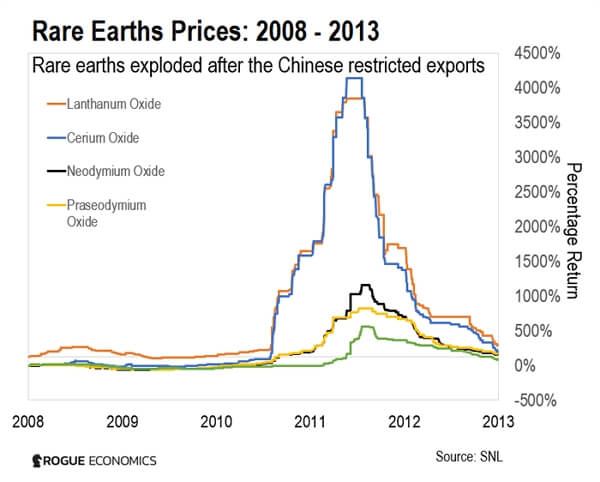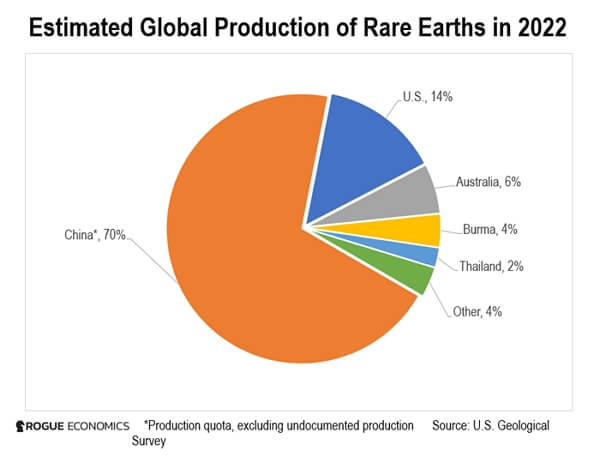China's Once-In-A-Decade Opportunity to Profit From These Commodities
Authored by: Nomi Prins
Over 2,100% - So, how that happened? CHINA. That’s the average gain that rare earth elements (REEs) delivered during its last bull market. Take a look at the chart below:

Between 2010 and 2011, Lanthanum and Cerium appreciated 4,141% and 2,978%, respectively. Junior rare earths mining stocks – smaller, exploration-type companies – did even better.
In 2010, the country stopped exports of rare earths to Japan. This was due to a diplomatic incident involving a Chinese fishing trawler that sparked a mania in rare earths and related stocks for about a year.
You may know that rare earth elements are used in everything from iPhones, electric vehicles (EVs), flat-screen TVs, and computers to sophisticated military equipment.
They are essential to modern life, much more so than they were back in 2010. But here’s the problem: Today's rare earths market is in a precarious situation.
You see, the current geopolitical conflict between the U.S. and China threatens to unleash a bull market of epic proportions in rare earths that could overshadow the 2010-2011 bull run.
There’s a lot at play here. So on Wednesday, May 10 at 8 p.m. ET, I’ll reveal how a new law is poised to unleash $4 trillion into a new energy subsector called “SMR.” Be sure to RSVP with one click right here.
SMR could solve America’s – and the world’s – energy problems. And only one firm has the federal license to produce this technology in America. So during my special briefing, I’ll tell you how you can play this company for less than $2 a share.
China Is Back at It Again
Mark Twain once said, "History never repeats itself, but it does often rhyme.” I was reminded of this recently when I saw headlines like this one: China Contemplating Export Ban on Rare Earth Magnets
According to a report by Nikkei, China is considering an export ban on “certain rare-earth magnet technology.” In other words, the Chinese government is going after high-performance rare earth magnets.
This is a huge deal. Here’s why - Rare earth magnets have many military applications.
They go into cruise missiles, bombers, rockets, drones, and other cutting-edge military equipment. The U.S. Javelin missiles and F-35 fighter jets are so packed with these magnets they are almost bursting at the seams.
And China produces and processes roughly 70% of global rare earth supplies. Have a look.

Former Chinese leader Deng Xiaoping once said, “The Middle East has oil. China has rare earths.” China knows the U.S. depends wholly on REEs for its most sophisticated military equipment. And party bosses in Beijing have wanted to hit the U.S. where it hurts for a while now.
For example, in February 2021, the Financial Times reported that the Chinese government had reached out to its rare earths industry and asked, “How much damage could we do to the U.S. military if we cut off rare earth exports? Could we cripple its production of new fighter jets?”
Also, China aims to use rare earths as a bargaining tool. That’s because, in the past year, the U.S. began to thwart China’s access to advanced semiconductor technology.
Through the CHIPS Act, the Biden administration moved to limit the export of U.S. chip technology to China, and the U.S. also brought on key chip-making countries like Japan and the Netherlands to the export limits.
And China is already behind when it comes to advanced semiconductors. For instance, it imports almost all the chips necessary for manufacturing electric vehicles.
So at this point, China choking off rare earth supplies isn’t wild speculation. The country has done it before over trivial matters.
And if history is any guide, there’s a good chance China’s rare earths ban will happen again soon.
What This Means for Your Money
If China bans rare earth exports, it can lead to another mania in this market. So how do you play this rare setup?
Now, keep in mind that investing in rare earths takes work. First, the list of quality companies mining rare earths is small. Plus, most companies that produce a meaningful amount are listed in China. So they’re difficult for everyday investors to access.
But there’s another way to take advantage of this opportunity. The VanEck Vectors Rare Earth ETF (REMX) - ETF stands for “exchange-traded fund, is a straightforward rare earths investment you can access with a regular brokerage account.
It holds companies producing, refining, and recycling rare earth and strategic metals and minerals. So it gives you broad exposure to the rare earths industry.
Now, it’s true that the fund holds quite a few China-based companies. That’s because it accurately reflects the current state of rare earth minerals as the world produces them today.
But as more countries start taking action to fight China’s dominance in the rare earths space, we can expect to see China’s percentage of REMX shift. Incidentally, one such country is the U.S.
In a follow-up essay, I’ll tell you about what America is doing to secure its supply of the metals we can’t live without.
Stay tuned for more.
This article was printed from TradingSig.com